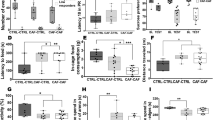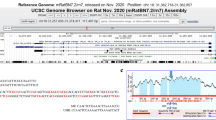Abstract
Chronic neuropathic pain has currently become a remarkable public health concern, considerably damaging not only the physiological but also the psychological aspects of humans. This study investigated whether neuropathic pain affects maternal care and assessed the effect of parental neuropathic pain on the development of neuropathic pain and emotion among offspring. Our results showed that mother rats suffered from chronic constriction injury (CCI) exhibited defective maternal care. The offspring fed by CCI mother rats (own or cross-fed) showed a significant increase in anxiety and anxiety-related behavior compared with that fed by sham-operated mother rats. The offspring fed by CCI mother rats also displayed decreased oxytocin expression in their supraoptic nucleus than that fed by sham-operated mother rats. Moreover, DNA methyltransferase (DNMT)1 expression in the amygdale was increased, whereas DNMT3a and DNMT3b expressions remained the same in offspring fed by CCI mother rats, as detected with immunohistochemistry and western blot analysis. In addition, the total DNA methylation in amygdale was upregulated in offspring fed by CCI mother rats. Considering the above findings, the data of this study suggest that parental neuropathic pain influences emotion-related behavior in offspring through maternal feeding behavior rather than through genetic factors and pregnancy experience that was associated with DNA methylation of amygdale in offspring.





Similar content being viewed by others
Abbreviations
- CCI:
-
Chronic constriction injury
- DNMT:
-
DNA methyltransferase
- HPA:
-
Hypothalamic–pituitary–gonadal axis
- PWT:
-
Paw withdrawal threshold
- PWL:
-
Paw withdrawal latency
References
Neville A, Peleg R, Singer Y, Sherf M, Shvartzman P (2008) Chronic pain: a population-based study. Isr Med Assoc J 10:676–680
Azevedo LF, Costa-Pereira A, Mendonca L, Dias CC, Castro-Lopes JM (2012) Epidemiology of chronic pain: a population-based nationwide study on its prevalence, characteristics and associated disability in Portugal. J Pain 13:773–783
Dworkin RH, O’Connor AB, Backonja M, Farrar JT, Finnerup NB, Jensen TS, Kalso EA, Loeser JD, Miaskowski C, Nurmikko TJ, Portenoy RK, Rice AS, Stacey BR, Treede RD, Turk DC, Wallace MS (2007) Pharmacologic management of neuropathic pain: evidence-based recommendations. Pain 132:237–251
Calvo M, Dawes JM, Bennett DL (2012) The role of the immune system in the generation of neuropathic pain. Lancet Neurol 11:629–642
Sacerdote P, Franchi S, Moretti S, Castelli M, Procacci P, Magnaghi V, Panerai AE (2013) Cytokine modulation is necessary for efficacious treatment of experimental neuropathic pain. J Neuroimmune Pharmacol 8:202–211
Price DD (2000) Psychological and neural mechanisms of the affective dimension of pain. Science 288:1769–1772
Mulder EJ, Robles de Medina PG, Huizink AC, Van den Bergh BR, Buitelaar JK, Visser GH (2002) Prenatal maternal stress: effects on pregnancy and the (unborn) child. Early Hum Dev 70:3–14
Coutellier L (2012) Rodent models of early environment effects on offspring development and susceptibility to neurological diseases in adulthood. Transl Neurosci 3:258–262
Fleming AS, Corter C (1988) Factors influencing maternal responsiveness in humans: usefulness of an animal model. Psychoneuroendocrinology 13:189–212
deCatanzaro D, Macniven E (1992) Psychogenic pregnancy disruptions in mammals. Neurosci Biobehav Rev 16:43–53
Perkins AV, Wolfe CD, Eben F, Soothill P, Linton EA (1995) Corticotrophin-releasing hormone-binding protein in human fetal plasma. J Endocrinol 146:395–401
Hobel CJ, Dunkel-Schetter C, Roesch SC, Castro LC, Arora CP (1999) Maternal plasma corticotropin-releasing hormone associated with stress at 20 weeks’ gestation in pregnancies ending in preterm delivery. Am J Obstet Gynecol 180:S257–263
Perkins AV, Linton EA, Eben F, Simpson J, Wolfe CD, Redman CW (1995) Corticotrophin-releasing hormone and corticotrophin-releasing hormone binding protein in normal and pre-eclamptic human pregnancies. Br J Obstet Gynaecol 102:118–122
Champagne FA, Meaney MJ (2006) Stress during gestation alters postpartum maternal care and the development of the offspring in a rodent model. Biol Psychiatry 59:1227–1235
Heim C, Newport DJ, Heit S, Graham YP, Wilcox M, Bonsall R, Miller AH, Nemeroff CB (2000) Pituitary-adrenal and autonomic responses to stress in women after sexual and physical abuse in childhood. JAMA 284:592–597
Champagne F, Diorio J, Sharma S, Meaney MJ (2001) Naturally occurring variations in maternal behavior in the rat are associated with differences in estrogen-inducible central oxytocin receptors. Proc Natl Acad Sci USA 98:12736–12741
Bennett GJ, Xie YK (1988) A peripheral mononeuropathy in rat that produces disorders of pain sensation like those seen in man. Pain 33:87–107
Chaplan SR, Bach FW, Pogrel JW, Chung JM, Yaksh TL (1994) Quantitative assessment of tactile allodynia in the rat paw. J Neurosci Methods 53:55–63
Hargreaves K, Dubner R, Brown F, Flores C, Joris J (1988) A new and sensitive method for measuring thermal nociception in cutaneous hyperalgesia. Pain 32:77–88
Zhang H, Cang CL, Kawasaki Y, Liang LL, Zhang YQ, Ji RR, Zhao ZQ (2007) Neurokinin-1 receptor enhances TRPV1 activity in primary sensory neurons via PKCepsilon: a novel pathway for heat hyperalgesia. J Neurosci 27:12067–12077
Bateson P, Barker D, Clutton-Brock T, Deb D, D’Udine B, Foley RA, Gluckman P, Godfrey K, Kirkwood T, Lahr MM, McNamara J, Metcalfe NB, Monaghan P, Spencer HG, Sultan SE (2004) Developmental plasticity and human health. Nature 430:419–421
Krey LC, Lu KH, Bulter WR, Hotchkiss J, Piva F, Knobil E (1975) Surgical disconnection of the medial basal hypothalamus and pituitary function in the rhesus monkey. II. GH and cortisol secretion. Endocrinology 96:1088–1093
Levine S (2001) Primary social relationships influence the development of the hypothalamic–pituitary–adrenal axis in the rat. Physiol Behav 73:255–260
Von Korff M, Dworkin SF, Le Resche L, Kruger A (1988) An epidemiologic comparison of pain complaints. Pain 32:173–183
McWilliams LA, Cox BJ, Enns MW (2003) Mood and anxiety disorders associated with chronic pain: an examination in a nationally representative sample. Pain 106:127–133
Field T (1998) Maternal depression effects on infants and early interventions. Prev Med 27:200–203
Hirshfeld DR, Biederman J, Brody L, Faraone SV, Rosenbaum JF (1997) Expressed emotion toward children with behavioral inhibition: associations with maternal anxiety disorder. J Am Acad Child Adolesc Psychiatry 36:910–917
Whipple EE, Webster-Stratton C (1991) The role of parental stress in physically abusive families. Child Abuse Negl 15:279–291
Champagne F, Meaney MJ (2001) Like mother, like daughter: evidence for non-genomic transmission of parental behavior and stress responsivity. Prog Brain Res 133:287–302
Francis DD, Champagne FC, Meaney MJ (2000) Variations in maternal behaviour are associated with differences in oxytocin receptor levels in the rat. J Neuroendocrinol 12:1145–1148
Fairbanks LA (1989) Early experience and cross-generational continuity of mother-infant contact in vervet monkeys. Dev Psychobiol 22:669–681
Miller L, Kramer R, Warner V, Wickramaratne P, Weissman M (1997) Intergenerational transmission of parental bonding among women. J Am Acad Child Adolesc Psychiatry 36:1134–1139
Latremoliere A, Woolf CJ (2009) Central sensitization: a generator of pain hypersensitivity by central neural plasticity. J Pain 10:895–926
Buchheit T, Van de Ven T, Shaw A (2012) Epigenetics and the transition from acute to chronic pain. Pain Med 13:1474–1490
Graff J, Rei D, Guan JS, Wang WY, Seo J, Hennig KM, Nieland TJ, Fass DM, Kao PF, Kahn M, Su SC, Samiei A, Joseph N, Haggarty SJ, Delalle I, Tsai LH (2012) An epigenetic blockade of cognitive functions in the neurodegenerating brain. Nature 483:222–226
Robertson KD, Uzvolgyi E, Liang G, Talmadge C, Sumegi J, Gonzales FA, Jones PA (1999) The human DNA methyltransferases (DNMTs) 1, 3a and 3b: coordinate mRNA expression in normal tissues and overexpression in tumors. Nucl Acids Res 27:2291–2298
Diorio J, Meaney MJ (2007) Maternal programming of defensive responses through sustained effects on gene expression. J Psychiatry Neurosci 32:275–284
Liu D, Diorio J, Tannenbaum B, Caldji C, Francis D, Freedman A, Sharma S, Pearson D, Plotsky PM, Meaney MJ (1997) Maternal care, hippocampal glucocorticoid receptors, and hypothalamic-pituitary-adrenal responses to stress. Science 277:1659–1662
Acknowledgments
This work was supported by a grant from the Science and Technology Department Foundation of Hunan (#2013SK3006) to Dr. Yang.
Conflict of interest
The authors declare that they have no conflict of interest.
Author information
Authors and Affiliations
Corresponding author
Electronic supplementary material
Below is the link to the electronic supplementary material.
11064_2015_1578_MOESM1_ESM.tif
Fig. S1 Comparison of emotion in parental rats among the four groups. (A) Anxiety was examined by conducting the elevated plus maze test; (B) Anxiety-related behavior was assessed by performing an open-field test. C1, male rats with CCI; C2, female rats with CCI; S1, male sham-operated rats; and S2, female sham-operated rats. * p < 0.05 vs. C1 and & p < 0.05 vs.C2. (TIFF 200 kb)
Rights and permissions
About this article
Cite this article
Zhong, T., Zhang, Y., Guo, Q. et al. Parental Neuropathic Pain Influences Emotion-Related Behavior in Offspring Through Maternal Feeding Associated with DNA Methylation of Amygdale in Rats. Neurochem Res 40, 1179–1187 (2015). https://doi.org/10.1007/s11064-015-1578-1
Received:
Revised:
Accepted:
Published:
Issue Date:
DOI: https://doi.org/10.1007/s11064-015-1578-1




